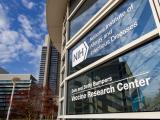Apr 11, 2006 (CIDRAP News) – A mathematical modeling study suggests that a modestly effective vaccine could keep an influenza pandemic from striking more than 10% of the US population, but only if large amounts of vaccine were distributed quickly and the virus was not too highly contagious.
With a more contagious virus, additional measures such as school closings, travel bans, and antiviral drugs would have to be used in combination with vaccination, says the report published online last week by the Proceedings of the National Academy of Sciences.
The modeling study seems to lend some support to the US strategy of stockpiling a vaccine based on recent strains of H5N1 avian flu, which won't precisely match an emerging pandemic strain. But the model incorporates many assumptions that may or may not prove accurate in the event of a pandemic, and experts note that very little H5N1 vaccine would be available if a pandemic occurred anytime soon.
With a moderately transmissible virus (meaning each case leads to fewer than 1.9 additional cases), "Our model suggests that the rapid production and distribution of vaccines, even if poorly matched to the circulating strains, could significantly slow disease spread and limit the number ill to less than 10% of the population, particularly if children are preferentially vaccinated," says the report by Timothy C. Germann and colleagues.
Germann and two associates, Kai Kadau and Catherine A. Macken, all of Los Alamos National Laboratory, worked on the study with Ira M. Longini Jr., a biostatistician from the Fred Hutchinson Cancer Research Center and the University of Washington in Seattle.
The study was supported by the National Institutes of Health (NIH). Its goals, the NIH said in a news release, were to determine how to slow the spread of a pandemic virus long enough to permit development and distribution of a well-matched vaccine and also how to limit the number of cases to less than 10% of the population, the percentage in an average flu season.
The model simulated the unfolding of pandemic flu in a US population of 281 million over 180 days. It factored in US census data about population distribution and commuting patterns and assumptions about the frequency of interpersonal contacts. It assumed that a few infected people would arrive from abroad each day at 14 airports in the United States. The researchers ran the simulations with four different reproductive (R) numbers (the number of additional people infected by each infected person), ranging from 1.6 to 2.4.
The model projected that without any control effort and an R of 1.9, the virus would spread across the nation within 30 days of its first arrivals, that 122 million people would ultimately fall ill, and that the pandemic would peak in 85 days. With an R number of 2.4 and no control effort, as many as 151 million would get sick, according to the model.
"Aggressive" production and distribution of vaccine could control a pandemic with an R of less than 1.9, the model predicted. "We believe that a large stockpile of avian-based vaccine with potential pandemic influenza antigens, coupled with the capacity to rapidly make a better-matched vaccine based on human strains, would be the best strategy to mitigate pandemic influenza," the authors write. "This effort needs to be coupled with a rapid vaccine distribution system capable of distributing at least 10 million doses per week to affected regions of the U.S."
Other control strategies used alone could limit a pandemic only if the virus had relatively low transmissibility (R of 1.6), the model predicted. For example, targeted use of antiviral drugs could succeed in that case, provided the supply was adequate and close contacts of patients could be quickly identified. But if R were 1.8, the nation would need a "prohibitively large" 51 million treatment courses of antivirals.
For a highly transmissible virus (R greater than 1.9), it would take a combination of measures to limit the pandemic, the model predicted. For example, the combined use of vaccination, targeted antiviral use (3 million courses), school closures, social distancing, and travel restrictions could work at an R level as high as 2.4, the authors predict.
Travel restrictions alone would accomplish little, according to the simulations. A 90% reduction in travel would slow the virus's spread by only a few days to a few weeks, depending on transmissibility, and would not dent the ultimate size of the pandemic.
With a very limited supply of a vaccine for which two doses are recommended, the model showed it would be less helpful to vaccinate a given number of people with the two doses than to give just one dose to twice as many people.
Other experts who were asked to comment on the study had different reactions.
William Schaffner, MD, a hospital epidemiologist and professor in the infectious disease division at Vanderbilt University in Nashville, said he found the study reassuring, though he had not examined it closely. "The ultimate take-home line was that even a partially effective vaccine is an important part of the strategy," he said.
He added that building up the capacity to treat the sick is important, but the main emphasis in pandemic preparedness should be on vaccination and other preventive measures. "The results [of the study] were so affirming of the general thoughts of the public health community that it's really very reassuring, and I hope it stimulates further what I think is already a strong effort by HHS [the Department of Health and Human Services] to stimulate vaccine production and research on new ways to produce the flu vaccine and make better flu vaccines."
Michael T. Osterholm, PhD, MPH, a leading pandemic preparedness advocate, had a sharply different view of the study. "I think it's based on a number of assumptions which in the real world won't happen," he said. "The idea that we'll even have vaccine to consider in terms of dealing with the pandemic is at this point not likely for the vast majority of the world."
Osterholm, director of the University of Minnesota Center for Infectious Disease Research and Policy, publisher of the CIDRAP Web site, said "any number" of assumptions used in the model could be questioned. "I continue to worry that far too much credence is being put into theoretical models that lack reality testing in the likely world of a pandemic," he said.
Dr. Gregory Poland, a vaccine expert at the Mayo Clinic in Rochester, Minn., said the situation with the H5N1 vaccine being made for the US government points up the problems with the predictions. As was reported recently, the vaccine seems effective in about half of recipients, but it takes 12 times the dose used in seasonal flu vaccines, he noted.
"A moderately effective vaccine would work if you could get it into enough people," said Poland, who directs the Mayo Vaccine Research Group and Program in Translational Immunovirology. "This current vaccine, if we used the whole world manufacturing capacity, offers enough doses for somewhere around 37.5 million people. So that's not an answer." He added that it may be necessary to make more than one vaccine, given the different clades (families) of H5N1 virus that have emerged.
Poland also said no one knows how contagious the next pandemic virus will be. "My understanding is that the estimated R number for the 1918 pandemic was right around 3," higher than the maximum of 2.4 used in the study, he said. "You wonder now if we truly have a novel subtype that's easily transmissible, given the travel we have, if we wouldn't have higher numbers. The average family is bigger than two people."
Germann TC, Kadau K, Longini IM, et al. Mitigation strategies for pandemic influenza in the United States. Proc Nat Acad Sci 2006 Apr 11;103(15):5935-40 [Abstract]
See also:
NIH news release
http://www.nigms.nih.gov/News/Results/FluModel040306




















